California
| |
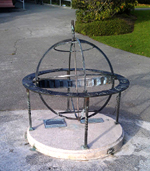 |
Arcata |
California |
USA |
Armillary Sphere |
Dial 192 |
| Armillary dial with horizon ring 4 ft. 4.5 in. diameter designed by Ken Lynch. Dial is made of brass and horizon ring has signs of the zodiac on it. Mounted at ground level with a separate plaque with Equation of Time. After the dial was installed the university ordered the point on the end of the gnomon sawed off. It was feared that someone might become impaled on it. Gift of Harvy S. Kieval, Professor Emeritus - Math. |
| |
| |
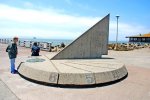 |
Berkeley |
California |
USA |
Horizontal Dial |
Dial 422 |
| At the edge of the bay is a round horizontal sundial about 10 feet in diameter with a stark triangular gnomon. Both gnomon and dial base are of hammered concrete. The base rises above the ground by about 2 feet where Arabic numbers encircle the dial to tell the hours. The dial face is not quite level, perhaps to help with water runoff. |
| |
| |
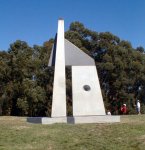 |
Berkeley |
California |
USA |
Sculpture/Artwork |
Dial 423 |
| This is a large granite statue by Richard O'hanlon entitled "Sunstone II" and was designed in collaboration with astronomer David Cudaback. A north-south large polished granite slab has the top cut at the latitude of 38 degrees to sight the North Star. A hole in the stone allows east or west viewing, with limiting angles designed to show the extent of maximum planetary and lunar wandering. An east-west stone crosses the north side of the granite slab, allowing light to pass only at noontime onto a heel stone with marks for Equinox and Solstice. Access by admission to the Hall of Science museum |
| |
| |
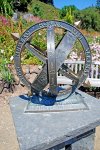 |
Berkeley |
California |
USA |
Armillary Sphere |
Dial 612 |
| The armillary dial is made of red bronze and rests on a quarried stone pedestal. The equatorial ring includes hour lines with 15-minute marks and Roman numerals. It was created by Frank Cheney, a UC Berkeley graduate, Class of 1941, and later donated to the Garden by his family. Mr. Cheney was a civil engineer who developed a hobby of building sundials. |
| |
| |
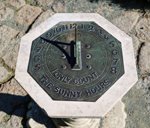 |
Berkeley |
California |
USA |
Horizontal Dial |
Dial 1064 |
| A 10 3/4 inch (27.3 cm) octagonal bronze horizontal dial is fixed to a marble tablet and rests on a thin pedestal for a total height of 32 inches (81.3 cm). Gnomon is badly bent. Has a round chapter ring with large hour marks in Arabic numerals. |
| |
| |
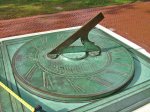 |
Berkeley |
California |
USA |
Horizontal Dial |
Dial 16 |
| A classic horizontal dial 16 inch diameter (41cm) made of bronze. Gnomon is 8 in. (29cm) long, 5 in. (13cm)high. Donated in 1915 by Class of 1877. Nicely engraved Roman hour numerals and delineated every 5 minutes. On the dial face is an Equation of Time table by date. The dial sits atop a marble pedestal, 4 foot (1.2m) high. |
| |
| |
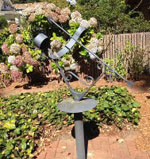 |
Capitola |
California |
USA |
Equatorial Dial |
Dial 786 |
| A wrought iron equatorial dial with an arrow rod gnomon. Equatorial band and support have iron scroll work depicting a bow and arrow. Dial is painted and hour numerals are obscured. |
| |
| |
 |
Carlsbad |
California |
USA |
Vertical Dial |
Dial 734 |
| A large vertical dial on an east-declining south stucco wall of an elevator tower in the parking lot of McClellan Airport. The gnomon, hour and declination lines and Arabic numerals are stainless steel. The dial design is flawed, incorrect for either a point-in-space nodus dial or a polar-inclined gnomon dial. The installed gnomon is horizontal but if intended to support only a nodus, the location is wrong; the nodus shadow is outside the lower declination line in the photos. The hour lines radiate from the gnomon base as for a polar-inclined gnomon; they should radiate from a point much higher if for a point-in-space nodus. |
| |
| |
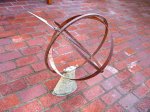 |
Carmel |
California |
USA |
Equatorial Dial |
Dial 179 |
| A simple 12 inch diameter equatorial ring dial of rusted steel on a cast iron base bolted to a brick floor. This replacement dial has Arabic numerals and the base has Zodiacal symbols. The original "Sundial Lodge" was renovated as a boutique hotel but during the construction the original horizontal dial was lost.
The original horizontal dial was about 16 in. diameter, made of bronze with a circular plate with Roman numerals on a plain concrete column and displayed the inscription, "Count none but the sunny hours." |
| |
| |
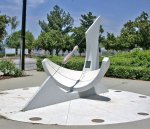 |
Claremont |
California |
USA |
Equatorial Dial |
Dial 505 |
| A 90 inch diameter spherical segment equatorial dial ten feet high of masonry construction with 3D fiberglass analemmic gnomon 40 inches long. Dial terrazzo face has hour, half-hour, quarter-hour and 5-minute marks with Roman hour numerals for PST. The 5-minute marks are one inch apart. Dial face includes analemma graphic with month dates; a plaque describes how to use the analemma graphic to select which side of the gnomon shadow to use to read time. Base perimeter has 12 ceramic plaques with Zodiacal signs.
Indicated time is accurate to one minute throughout the winter and to five minutes in summer. This is remarkable because the dial is located just outside a children's playground and children routinely climb on the dial and swing from the gnomon. An animation from digital images showing the gnomon shadow motion over the course of a full year is available.
Dedicated as the Ralph B. Larkin Memorial Sundial. Rev. Larkin was a retired missionary who taught science to children for 17 years in Claremont. Dr. Larkin's father was Edgar Lucien Larkin, Director of the Mt. Lowe Observatory above Los Angeles 1900-1924 using a 16-inch Alvan Clark refractor telescope, described by Alvan Clark as, "the finest telescope I ever made." Ralph Larkin often said, "I grew up with a telescope." The Mt. Lowe Observatory was destroyed in a windstorm in 1928 and the Alvan Clark refractor was moved to Ricard Observatory at the University of Santa Clara, California. |
| |
| |
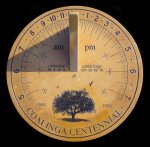 |
Coalinga |
California |
USA |
Horizontal Dial |
Dial 764 |
| A 26 inch diameter hand-carved, lacquer-coated beige sandstone horizontal dial set flush in a massive cast concrete pedestal. Dial has a thick stone gnomon, hour, half-hour and quarter-hour lines with Arabic ST hour numerals corrected for longitude. Face is marked with symbols showing sunrise and sunset times on solstices and equinoxes and with location coordinates. Dial face includes a hand carved graphic of a Valley Oak tree, symbolic of the San Joaquin Valley dial location.
The dial is embedded in a three foot cube cast concrete pedestal bearing a bas relief image of a horned toad, mascot of the Coalinga High School and the city centennial dates 1906 - 2006. |
| |
| |
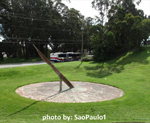 |
Colma |
California |
USA |
Horizontal Dial |
Dial 21 |
| This large ground-level horizontal dial is 40 ft. diameter. Formerly a floral dial with a cypress tree as gnomon and hour lines crafted out of plants such as santilina shrubs. During the 1960's the dial was changed to concrete and aluminum. Now approaching 2020, the concrete dial has a brick surround. Time is marked by large Roman numerals and hour lines in an interior chapter ring. The gnomon is a supported beam with a graceful shaped tip. It may be aluminum, but shows signs of weathering. |
| |
| |
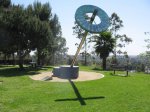 |
Culver City |
California |
USA |
Equatorial Dial |
Dial 536 |
| Located near the edge of a hill in Culver Park, this dial commands a fine view of the surrounding communities. The equatorial dial face is a six foot diameter, six inch thick brass ring supported by a 24 foot long steel gnomon six inches in diameter. The gnomon is anchored in a concrete oval-shaped base covered with tile and mosaics. The base and three surrounding water-drop shape ovals are inscribed with the word "Time" in the 12 languages spoken in Culver City. Ballona Creek, visible from the sundial, once provided transportation, food and recreation for a thriving native American population and later for Spanish-origin ranch owners. The dial north face has the 1:00 hour line at the bottom for Daylight Savings Time while the south face has the 12:00 hour line at the bottom for standard time. A bronze plaque states time is read from the center of the gnomon shadow and briefly discusses the equation of time. The dial is not longitude corrected and indicates local apparent time. |
| |
| |
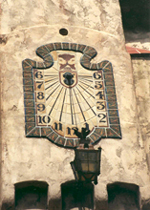 |
Death Valley |
California |
USA |
Vertical Dial |
Dial 76 |
| Prospector and con man Walter Scott convinced Chicago millionaire Albert Johnson to invest in his gold mine in the Death Valley area. The mine was a fraud, but Johnson began building his Spanish Revival Villa in 1922 that continued until the stock market crash of 1929. Martin de Dubovay was the architect, Mat Roy Thompson was the engineer and head of construction, and Charles Alexander MacNeilledge was the designer |
| |
| |
 |
El Cajon |
California |
USA |
Armillary Sphere |
Dial 214 |
| Armillary dial about 3 ft. diameter designed by Don LeGrande. As of Christmas 1992, a stunning armillary sphere-type of sundial ... The framework of the dial is constructed of burnished stainless steel. ... The rod-like gnomon was destroyed by vandals many years ago, but the rest is in good shape. |
| |
| |
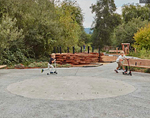 |
Felton |
California |
USA |
Analemmatic Dial |
Dial 1127 |
| This analemmatic sundial is set in a concrete circle about 12 feet (4m) in diameter. It has a plain zodiac walkway with month abbreviations. The hourly numbers are set in an ellipse appropriate for the 37 deg latitude. Unfortunately the dial is in shade during the early morning hours. |
| |
| |
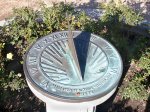 |
Fullerton |
California |
USA |
Horizontal Dial |
Dial 529 |
| This 18-inch cast bronze horizontal dial is located in front of Heritage House, the relocated office and home of early Fullerton physician Dr. George C. Clark. The gnomon edge is tapered to a single style. Dial sits atop a cylindrical cast concrete pedestal 28-inches high. |
| |
| |
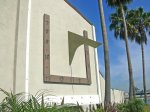 |
Huntington Beach |
California |
USA |
Vertical Dial |
Dial 78 |
| A 7x8 foot direct south facing vertical dial of wood with metal gnomon on the masonry stucco side of a fire station building. Hour lines are painted on wood planks bolted to the side of the building. Metal Arabic DST hour numerals are mounted to the wood planks. Longitude correction is not included and there is no EOT correction or instructions offered but dial is accurate when both corrections are applied. |
| |
| |
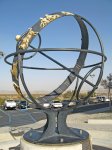 |
Joshua Tree |
California |
USA |
Armillary Sphere |
Dial 625 |
| A 5 foot diameter steel armillary sphere with 6 foot gnomon rod. Inner surface of equatorial ring has cast Roman numerals; outer surface has cast Zodiac signs colored gold. Sphere is supported by 13 inch high four-flange base. Dial sits on a 42 inch high cast concrete cylindrical base. |
| |
| |
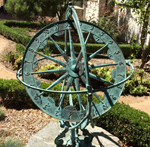 |
La Canada |
California |
USA |
Armillary Sphere |
Dial 881 |
| The bronze equatorial dial is about 24" diameter, and has equatorial, meridian and horizon rings. It sits on top of a stone pedestal. The equatorial ring is supported by 24 spokes, spaced at 15 degrees. Around the rim 24 hour numerals in Arabic. The twelve signs of the zodiac are spaced every other hour on the equatorial rim. The orientation to true north and inclination were verified to be correct for the site. The sundial was a gift from the Kresser Smith family to the Descanso Gardens Guild in 1987 on the occasion of the guild's 30th anniversary. |
| |
| |
 |
Los Altos |
California |
USA |
Obelisk or Vertical Gnomon |
Dial 498 |
| A triangular entry canopy 13 feet height by 128 feet wide by 26 feet deep at the Georgina Blach Intermediate School casts a shadow on the front pavement walkway. The pavement is etched with a gnomonic projection to show the hours and seasons. The dial was created by architects Lisa Gelfand and Andrew Davis who did considerable research for the dial. Their design was submitted to the school district for approval. It's a fun sundial and the students and teachers love it. |
| |
| |
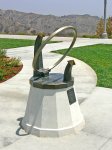 |
Los Angeles |
California |
USA |
Equatorial Dial |
Dial 77 |
| A bronze equatorial ring dial with taut wire gnomon on concrete pedestal. Ring is inscribed with hour, ten-minute and minute lines. Plaque states the dial indicates correct watch time so observatory staff periodically rotates clamped ring to correct for EOT, longitude and DST. Dial is located adjacent to the Astronomers Monument atop which is a large bronze armillary. The monument recognizes Hipparchus, Copernicus, Galileo, Kepler, Newton and Hershel. The sundial was originally built into the base of the Astronomers Monument but was relocated a few feet to the south during the 2002-2006 remodeling to allow visitors to more closely approach the dial. The dial sits atop a concrete pedestal. |
| |
| |
|
Los Angeles |
California |
USA |
Sculpture/Artwork |
Dial 309 |
| A sundial sculpture by Martha Oathout Ayers. More information about this dial is needed. |
| |
| |
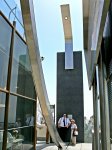 |
Los Angeles |
California |
USA |
Sun Alignment |
Dial 593 |
| A bronze-faced meridian arc dial 18 feet long, 13.5 feet high and 7 inch wide. Displays the meridian line and is inscribed with month and day markings, seasonal and lunar indicators and constellation figures. An overhead lens projects a solar image on the inscriptions. A large adjacent symbol is positioned to indicate which set of date markings is to be read from the meridian line. In a modern twist, photoelectric sensors embedded in the face of the arc are activated by the transiting spot of sunlight and send a signal to illuminate LED indicators on the 22 foot wide stainless steel ecliptic chart overhead, lighting up the stars of the constellation through which the sun is passing. |
| |
| |
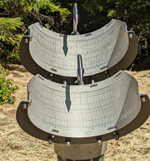 |
Manchester |
California |
USA |
Equatorial Dial |
Dial 1117 |
| This is a double equatorial sundial of stainless steel (slightly burnished to show the shadow without reflections). Each cylinder is approximately 16 inches (40cm) in diameter. with hour lines drawn as analemmas (June to Dec and Dec to June). The gnomon are two pointed steel rods, reading the time and date at the shadow tip. Declination lines are shown for each month, and if you can interpolate the monthly date lines, the sundial can be read to about 30 seconds accuracy. The double equatorial sundial sits on a mounting pole that at one time held a solar array. " The round pole allowed me to set azimuth and level easily, altitude from latitude with a digital plumb, then I then used the sundial adjustments to get the meridian offset and tweaked it all on the equinox using GPS time." |
| |
| |
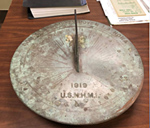 |
Mare Island |
California |
USA |
Horizontal Dial |
Dial 1076 |
| Farenholt sundial for U.S. Naval Hospital Mare Island. Cast bronze, 18 inch (46 cm) diameter circular face, mounted on a cement pedestal 40 inches tall. Only three Farenholt sundials are known to have Spanish mottos: Mare Island is one of them. (Sunnyvale, CA and Hawthorne, NV are the others). We notice other difference from the classic Farenholt sundial: (1) there is no true chapter ring for the hour marks. They are at the end of long hour lines that extend from 4am to 8pm. All other dials are from 6am to 6pm. (2) The hours are delineated in quarter hours. All other dials are delineated in half hours. (3) The gnomon foot is considerably below center (and appears restored) with a raised style edge that is more “art deco” than the curves of other Farenholt gnomons. (4) The naval command is not spelled out. Rather, just the initials “U.S.N.H.M.I”. All other Farenholt dials spell the naval command in full. (5) The date is placed above the command initials. All other dials have the date below the naval command title. (6) There are no Farenholt initials on the dial’s southern edge. All of this may indicate the haste with which the dial was made, perhaps to memorialize those that died in Vallejo due to the 1918-1919 influenza epidemic. |
| |
| |
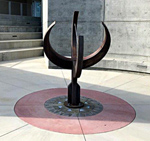 |
Mission Viejo |
California |
USA |
Equatorial Dial |
Dial 1136 |
| This steel equatorial dial is about 4-foot (1.2m) in diameter with the equatorial and meridian arcs in the shape of thin crescent moons. The 10-minute time marks are appropriately offset for the dial's longitude about 2.3 degrees (9 minutes) east of the pacific time zone meridian. The offset is marked with "Local Solar Noon".. Arabic numbers mark the hours from 6am to 6pm. The dial stands on a steel pillar with a compass rose at the foot. The whole dial is in a concrete circular plaza.. The dial and pillar all suffer rust. |
| |
| |
|
Mount Laguna |
California |
USA |
Equatorial Dial |
Dial 170 |
| The odd bowl-shape of this equatorial dial designed and built by C.T. and W.M Thwaites shows a reversed engraved map of the world. A horizontal bar across the bowl has a small metal nib which points out the time of the day (top and bottom for standard and daylight times) and also indicates the spot on the world where the Sun is currently directly overhead. On full Moon nights, this dial has been used to effectively tell time and show the position of the Moon over the Earth as well. |
| |
| |
 |
Mountain View |
California |
USA |
Analemmatic Dial |
Dial 1037 |
| Analemmatic sundial 16' x 10' (4.8m x 3m) painted as a full ellipse on the driveway to a house. Shows local solar time. Time corrections to obtain civil time (Equation of Time and longitude offset) are given for the first of each month on the Zodiac Walkway. Sunrise and Sunset sighting points (seasonal or "Bailey" points) are provided for a theoretical horizon, but are not useful as the dial site is within a valley. The perimeter of the ellipse is marked with great circle navigation directions for a selection of historical solar and celestial observatories, especially for North America, but all historically inhabited continents are represented. A QR code is provided for a link to a website with instructions for the dial, reference links on sundials (including NASS), and links for the selected observatories on the perimeter. The 2 degree slope of the driveway was not compensated for in the sundial layout, but the dial is unshaded from roughly 9:00 am to 5:00 pm in the summer. |
| |
| |
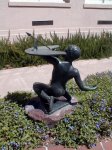 |
Oakland |
California |
USA |
Sculpture/Artwork |
Dial 307 |
| Bronze sundial sculpture by Robert Paine. The sundial was donated to University High School in 1927 by Sara Bard Field in honor of her son Albert, who was killed in 1917 in an automobile accident. Albert was the high school senior class president in 1917. His mother Sara was a leading suffragist on the West Coast. The High School has been renovated and now used by Children's Hospital Oakland Research Institute (CHORI). |
| |
| |
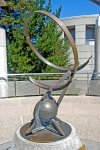 |
Oakland |
California |
USA |
Reflective Equatorial |
Dial 613 |
| One of Bill Gottesman's unique-design Renaissance dials of cast and structural bronze with a 27 inch diameter helix with a celestial-north aligned axis. Time is told by a focused beam of light that moves around the helix throughout the day. The light beam is reflected from a long cylindrical unsilvered mirror in a structure that supports the helix. A sliding time scale within the helix can be adjusted for EOT and DST and includes longitude correction. Once this scale is adjusted for date, the dial shows civil, or clock, time. The dial base is cast bronze allowing adjustment for latitude and placed on a concrete pedestal. |
| |
| |
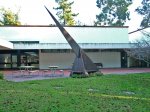 |
Oakland |
California |
USA |
Horizontal Dial |
Dial 236 |
| Large horizontal dial, with steel gnomon 26 ft. (8m) long, 16 ft. (5m) high, and 6 ft. (2m) wide. It looks like a sculpture of three interlocking triangles. The triangles of 2-inch thick Cor-Ten steel plates create the dial's gnomon and supporting structure. Overall, the sundial weighs about 5,700 pounds. The dial sits in a courtyard where the only hour markers are placed on the lawn and brick patio around the dial. EOT values for every 5 days are shown on the north face of the support. |
| |
| |
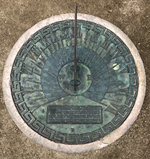 |
Palo Alto |
California |
USA |
Horizontal Dial |
Dial 900 |
| This horizontal bronze dial is 14.5 inches in diameter, mounted on a fluted pedestal. The gnomon angle is set for the latitude and is 5 5/8 inches tall. Graceful hour lines extend from 5am to 7pm marked by Roman numerals. It is delineated only with half-hour lines. Surrounding the dial face is a zig-zag decoration. |
| |
| |
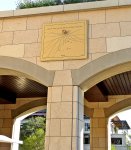 |
Palo Alto |
California |
USA |
Vertical Dial |
Dial 482 |
| A vertical declining dial approximately 45 x 55 inches. Made of aluminum and brass. Shows the hours from 8 am to 5 pm using analemmas. Analemmas are bounded by the summer and winter solstices and a straight line through them shows the equinox. Daylight time is shown using Roman numerals, with standard time shown in Arabic. In keeping with the motto, a simple equation is written on the dial face, d/dt is not equal 0.
Designer Ronald Bracewell used an oculus, a disk with a central hole, standing 8 cm in front of the dial face. The disk casts a shadow with a bright sunlight dot to indicate both time and season. Hour lines include longitude correction.
This has been relocated; it was previously hanging free below a south facing wall, facing the Terman Engineering Building. Dial is now located on the wall of a covered walkway area. |
| |
| |
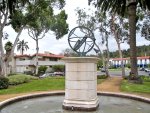 |
Palos Verdes Estates |
California |
USA |
Armillary Sphere |
Dial 740 |
| A 1.5 meter diameter bronze armillary sphere atop a beige stone pedestal at the center of a 9 meter diameter pond or fountain. The Armillary includes meridian, equatorial and horizon rings as well as Arctic and Antarctic circles. The equatorial ring is perforated with Roman hour numerals and Zodiacal symbols. The central gnomon rod has a ball at the north end and an arrow tail at the south end. |
| |
| |
 |
Pasadena |
California |
USA |
Analemmatic Dial |
Dial 643 |
| A 14x8 foot analemmatic dial with an 8x2 foot gnomon-positioning calendar plinth. The dial is installed in the pebble and concrete patio of the Winnett Student Center. The hour markers and calendar line plinth are made of Granodiorite of Knowles, a muscovite-bearing biotite granodiorite rock quarried from Knowles Quarry at Raymond, California. A nearby wall plaque provides longitude and EOT correction. The dial is a gift from the Caltech Alumni Association as a sculpture, a public artwork and a scientific instrument. This dial is located on the private university campus but the public may walk on the campus grounds to view the dial. |
| |
| |
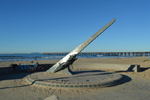 |
Port Hueneme |
California |
USA |
Horizontal Dial |
Dial 997 |
| A large, 20 ft. diameter horizontal bronze dial constructed in memory of Alaska Airlines Flight 261, which crashed 14 miles offshore nearby on January 31, 2000, with the loss of all aboard. 88 bronze plaques surround the dial on its beveled edge honoring passengers and crew who died. The dial face is simple without hour lines but Roman numerals from 8am to 4pm to mark the hours. The thin, gleaming gnomon is decorated with dolphins at the base symbolizing the sea into which the plane fell. The sundial is set in a circular plaza 36 feet in diameter. |
| |
| |
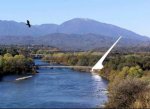 |
Redding |
California |
USA |
Horizontal Dial |
Dial 518 |
| When is a bridge not a bridge? When it's almost a sundial. The 217 foot high suspension span called Sundial Bridge wants to be a sundial, and has come very close. The suspension pylon is aligned true north, but unfortunately performs as an inaccurate gnomon with an inclination of 49 deg (for bridge functionality) rather than for the 40.6 deg latitude of the site. The bridge is 700 feet long and weighs 1,600 tons. Funding for the bridge comes from the McConnell Foundation, Redding Redevelopment Agency, Federal Highway Administration, and Turtle Bay Exploration Park |
| |
| |
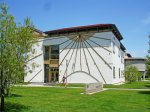 |
Redlands |
California |
USA |
Vertical Dial |
Dial 658 |
| A 60x40 foot vertical dial of stucco, wood and brass, filling the south exterior wall of the building. Roman hour numerals show PST; Arabic hour numerals show PDT. Summer and winter solstice and the equinox lines are shown; the shadow of a nodus on the gnomon indicates the date.
Dr. Nordgren explains that the shadow of the 10-inch diameter nodus "is just the right size to take into account periods when sundials are fast or slow relative to clock time. When dials run their slowest, the leading edge of the nodus shadow gives the accurate time. During periods when dials run their fastest the trailing edge gives the accurate time."
Dr. Nordgren was among the seven designers of the sundials used on the NASA Mars Rovers in 2004. |
| |
| |
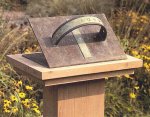 |
Redlands |
California |
USA |
Equatorial Dial |
Dial 293 |
| Equatorial dial designed by Russ Busher. A semicircle of metal, pierced with numerals. Sun shines through numerals onto metal plate with vertical line mounted below. Semicircle in equatorial plane, plate in polar plane. Such a dial is frequently advertized in "Wind and Weather" catalog. Placed atop a wooden post. |
| |
| |
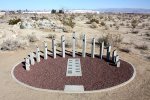 |
Ridgecrest |
California |
USA |
Analemmatic Dial |
Dial 679 |
| A 20x15 foot axis analemmatic dial built of cement hour posts, metal markers and tile and lava rock on the high desert floor outside the museum building. |
| |
| |
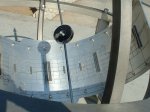 |
Riverside |
California |
USA |
Equatorial Dial |
Dial 18 |
| An equatorial dial 47 inches in diameter made of stainless steel. It sits upon four sleek pillars setting on a concrete rise. The gnomon rod has a round disk with a hole to act as a nodus. The dial equatorial band has solstice and equinox lines, as well as a line showing the declination of the sun marked with by months and zodiac signs. Hour lines are marked by raised stainless steel Roman Numerals. Dial is corrected to Pacific Standard Time. |
| |
| |
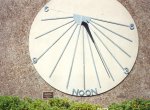 |
Rocklin |
California |
USA |
Vertical Dial |
Dial 238 |
| Small, circular 12.5 in. vertical dial mounted 56 in. above ground on the south wall of the library. Dial is aluminum mounted on concrete. Hour line missing from 6AM to gnomon base. Wall faces 26 degrees SW. Hour lines, numbered only at 6, 9, 12, 3 and 6. Two memorial plaques adjacent to dial. One reads 'Sierra College Honors/ E. R. 'Russ' Fallon/ for Dedicated Services/ Building Inspector/ Building and Grounds Supervisor/ 1959-1975'. Other reads 'In Admiration and Fond Memory/ of Our Colleague/ Dwight Hall/ 1927-1972/ by the/ Academic Senate and Friends/ at Sierra College.' |
| |
| |
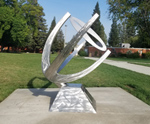 |
Sacramento |
California |
USA |
Equatorial Dial |
Dial 1024 |
| A 6 foot wide x 5-foot high burnished stainless steel equatorial sundial. The meridian arc is parabolic shaped and the equatorial arc is slightly more than a gracefully tapered half-circle 5 1/2-feet in diameter. The central elliptical gnomon plate, which swivels to face the sun, has an analemma cutout that casts an accurate civil-time shadow onto the equatorial ring below. The gnomon plate is laser-etched with the analemma, months and 365 days of the year, and marks for the equinoxes and solstices, and instructions. The equatorial timeline is laser-etched with hour and minute marks from 6:30 AM to 6:30 PM. The sundial body rotates and locks in position for either Daylight Saving or Standard Time. The sundial is highly accurate compensating for longitude (the equatorial ring is rotated 5min 24 sec early to measure solar time on the pacific meridian) and equation of time (by reading the east or west edge of the analemma plate gnomon shadow). The sundial often indicates clock time to within seconds and the date to within a portion of the day. A stainless steel base cover encloses the mounting hardware beneath. |
| |
| |
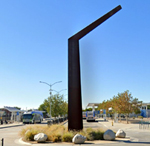 |
San Bernardino |
California |
USA |
Horizontal Dial |
Dial 1041 |
| This is a monumental horizontal sundial that from the ground simply looks like a giant pole with a slanting beam. High above the ground that beam is actually a segment of a gnomon, casting its shadow on the concrete plaza below. Then, if the eye is discerning, the concrete alternates in light gray and darker gray motif for the hour sections. From space (or Google Earth) the layout of the hour angles is clearly visible, radiating from a point considerably south of the gnomon pole, showing the hours from 9AM to 3PM local solar time. Hour line plaques extend from 10AM to 7PM. |
| |
| |
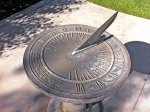 |
San Bernardino |
California |
USA |
Horizontal Dial |
Dial 188 |
| A 23 inch diameter horizontal bronze dial with 12 inch high gnomon and with hour, half-hour and quarter-hour lines from 5:30 AM to 7:30 PM and Roman hour numerals from 5 AM to 7 PM. Dial sits atop a 27 inch diameter stone pedestal 37.5 inch high. |
| |
| |
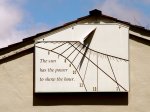 |
San Carlos |
California |
USA |
Vertical Dial |
Dial 424 |
| This vertical dial is approximately 4 foot high by 6 foot long, mounted on the end wall of a house that can be publicly viewed. Dial has hour lines and lines marking the equator and solstice shadow limits. Made of wood and brass. |
| |
| |
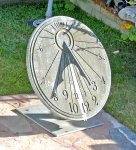 |
San Diego |
California |
USA |
Vertical Dial |
Dial 80 |
| This dial was originally owned and installed at Sea World in San Diego but was sold and purchased by Verlyn Kuhlmann. A 39 inch diameter reclining vertical dial of cast concrete with a 20 inch long steel gnomon. Dial reclines about 50°. Includes cast hour lines with Arabic numerals and longitude correction. A separate plaque provides instructions and an EOT graph. The dial is mounted on a 24 inch square aluminum base plate and short column support. |
| |
| |
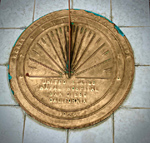 |
San Diego |
California |
USA |
Horizontal Dial |
Dial 1079 |
| Farenholt sundial for U.S. Naval Hospital San Diego California. This cast bronze dial was designed and commissioned by RADM Farenholt for U.S. Naval Hospitals at bases where he was commanding officer, visited, or had special meaning to him. The dial is 18 inches (46cm) in diameter. The outer chapter ring has the motto, followed by a chapter ring with Arabic hours 6am to 6pm, raised hour lines that radiate from near the foot of the gnomon and short half-hour lines. The gnomon has graceful curves original had a trefoil cut-out in the center. The restored gnomon has an irregular cut-out based on a photo of the original gnomon's shadow. Below the gnomon is the naval command name, followed by the commissioning date in the southern portion of the hours chapter ring. Dial has been restored, now having a gold luster. |
| |
| |
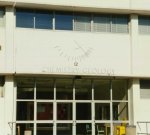 |
San Diego |
California |
USA |
Vertical Dial |
Dial 19 |
| Above the southwest entrance of the Chemistry-Geology Building is a vertical declining dial built by Richard L. Threet in 1979. The dial uses thin aluminum tubing as a gnomon to cast shadows on a ring of hour and half hour lines approximately 9 feet in diameter. The lines were originally painted black on the white concrete wall with only the 9 am, 12 noon, 3 pm and 6 pm lines boldly numbered. Since then the dial has lost all but the 12. |
| |
| |
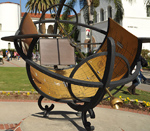 |
San Diego |
California |
USA |
Equatorial Dial |
Dial 815 |
| This broad band equatorial dial was dedicated in 1978 to George A. Koester, former Executive Dean of San Diego State University. The approximately 3-foot dial is on a brick pedestal situated on on a small dais. Concentric brick circles complete the large dial plaza. |
| |
| |
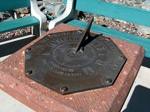 |
San Diego |
California |
USA |
Horizontal Dial |
Dial 213 |
| This is not the Koester dial at SDSU, but a far more interesting horizontal dial originally dedicated to the San Diego Normal School for elementary teaching by the class of June, 1911. The 18-inch octagonal bronze dial was originally designed by San Diego Clock maker Joseph Jessop and mounted on a miniature Doric column. The dial was placed within the circular lawn directly in front of the school's main entrance at the intersection of Park and El Cajon Boulevards. |
| |
| |
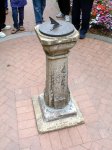 |
San Francisco |
California |
USA |
Horizontal Dial |
Dial 420 |
| A small 10-inch cast iron dial from England honors Shakespeare in a garden of the same name. The dial is on a small pedestal in the middle of the courtyard walkway and surrounded by trees. Lovely, but many shadows pass over the dial during the day. The dial plate was made for latitude 54 degrees. The gnomon appears to have been cut down to accommodate the 38 degrees for San Francisco. This "hack" method of correcting a sundial does not give correct time. |
| |
| |
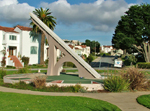 |
San Francisco |
California |
USA |
Horizontal Dial |
Dial 82 |
| Built in 1913 as a promotion for a housing development that was once a racetrack, this dial boasted (incorrectly) that at 34 feet in diameter and a gnomon style 28 feet in length, it was the largest known dial in the western world. Nevertheless it gathered much publicity and newspaper articles thanks to the Urban Realty Improvement Co. The company put out a brochure "The Sundial at Ingleside Terrace with Comments on Homes" using the sundial as a lure to attract home buyers to the newly constructed residential neighborhood. On Oct 10, the same day the Panama Canal was opened, a festive gala was held at the sundial dedication attended by more than 1500 people. Photos show young girls dancing around a small pool that surrounded the gnomon. A light (visible in several early photos) dangled from the tip of the gnomon. Bronze statues of seals were originally in the pool, but by 1920 the pool was filled with concrete and the seals were gone. Today the pool area is painted green. |
| |
| |
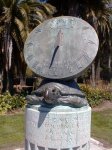 |
San Francisco |
California |
USA |
Vertical Dial |
Dial 20 |
| Known as the "Navigators' Dial", this sundial is dedicated to three early explorers of the California coast. The dial itself is a sliced bronze globe of the earth sitting on the back of a tortoise. Overall, the globe hemisphere is about 2 1/2 feet in diameter, showing the world in relief centered on California. The flat face of the hemisphere is a beautiful vertical reclining dial. The dial sits atop a cylindrical stone column. |
| |
| |
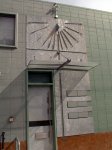 |
San Francisco |
California |
USA |
Vertical Dial |
Dial 421 |
| Dial is on an outside wall above the entrance to a private residence. The dial was designed by Stan Musilek. The dial back is made out of galvanized steel. Metal rails indicate the hours. Instead of Arabic or Roman numerals, the proper number of steel balls indicate the time of each hour. Overall, the dial is 4 by 6 feet. |
| |
| |
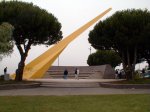 |
San Francisco |
California |
USA |
Horizontal Dial |
Dial 419 |
| Hilltop Park was built by the San Francisco Redevelopment Agency in 1987. The Landscape Architect was Michael Painter and Associates. Here is a giant sundial 70 feet in diameter with a bright yellow painted steel gnomon 78 feet long. The dial has a cement base and was designed to be used as the stage for a surrounding amphitheater. Dial shows wear and abuse, with graffiti covering the lower portion of the gnomon. Still, it is awe inspiring. |
| |
| |
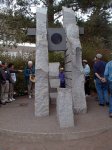 |
San Francisco |
California |
USA |
Sun Alignment |
Dial 418 |
| This is a 16 ton granite statue by Richard O'Hanlon entitled "Sunstone I" and was designed in collaboration with astronomer David Cudaback. A small wall of rock with a round inlay of dark stone is supported high upon two tall vertical slabs of granite. At the back is a "heel stone" with marks to show where the sunlight strikes at the Equinox and Solstice. |
| |
| |
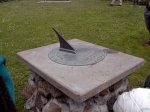 |
San Francisco |
California |
USA |
Horizontal Dial |
Dial 417 |
| A plain but nicely done brass horizontal dial about 2 feet in diameter mounted on a simple concrete pedestal. The dial is in good condition, but about 50 degrees out of alignment. |
| |
| |
 |
San Ramon |
California |
USA |
Equatorial Dial |
Dial 726 |
| This 5 x 5 x 6.5 foot stainless steel bow-string equatorial sundial is a precise heliochronometer with internal cam mechanism to correct for the Equation of Time. This exceptional dial is made of welded stainless steel sheet and weighs 330 pounds according to the designer Lee Palmer Stephenson. The dial face of the 60 inch diameter equatorial ring is marked with hour, half-hour, 15 minute, 5 minute and one minute lines and Arabic hour numerals showing PST and PDT. |
| |
| |
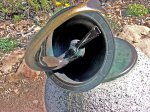 |
Santa Barbara |
California |
USA |
Equatorial Dial |
Dial 232 |
| A small bronze equatorial dial made by Victor E. Edwards in the 1920's. It has an unusual crescent shaped arm with notch at the upper end. The arm is rotated until sunlight through the notch strikes an analemma on the lower inner curve of the crescent. Time is then read on a circular dial from an "hour hand" pointer extending from the base of the crescent. The dial is mounted on a granite pedestal with spherical top 21 inch high. |
| |
| |
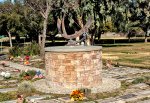 |
Santa Clara |
California |
USA |
Equatorial Dial |
Dial 774 |
| A 5 foot 9 inch wide cast bronze ring equatorial dial on a low brick mortared pedestal. The full semicircular hour ring has hour, half-hour, fifteen minute and 5 minute marks, and Roman hour numerals. The dial is lightly patinated and has a central gnomon rod with arrowhead. |
| |
| |
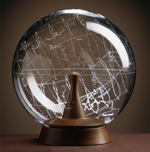 |
Santa Cruz |
California |
USA |
Globe or Hemispheric |
Dial 824 |
| This is a globe dial with a twist: a glass sphere is used to represent the earth with continent lines scribed on the globe along with hour lines, analemma figure for each hour, tropic of cancer, tropic of capricorn, equator, and a line representing the local horizon. The globe is etched with the dial site at the globe's zenith. The dial has a central gnomon. When the shadow of a pointer falls on the gnomon the time is read using the correct side of the hour line analemma. |
| |
| |
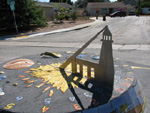 |
Santa Cruz |
California |
USA |
Horizontal Dial |
Dial 1044 |
| This is a colorful dial raised on a dais so that traffic doesn't hit it. Called "Light Time", the center of the dial has an artful yellow-orange impression of a sun surrounded by planets, moons and even a comet. Hours are marked in two colors for standard and savings time. The gnomon is 3/8 inch steel in the silhouette of a light house beneath the style line acting as a beam of light. |
| |
| |
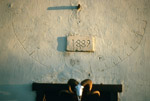 |
Santa Cruz Island |
California |
USA |
Vertical Dial |
Dial 899 |
| This vertical dial has undergone a number of restorations since it was set in lime in 1889. A photograph from 1900 shows the placement of a gnomon rod is horizontal. In 1992 before the National Park Service restoration in 2012 the gnomon is set in a polar orientation. But it doesn't really matter since the hour lines are marked at nearly regular 15 degree intervals with half hour sub-marks. |
| |
| |
 |
Santa Rosa |
California |
USA |
Horizontal Dial |
Dial 476 |
| This bronze horizontal dial is about 14in (356cm) in diameter with simple hour lines radiating from the gnomon foot to the circumference where Roman hour numbers mark the hours from 5am to 7pm The dial stands in the middle of a bronze lotus flower about 80in (2m) in the round. |
| |
| |
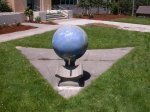 |
Sebastopol |
California |
USA |
Globe or Hemispheric |
Dial 522 |
| The sundial is a cement globe of the earth 28 inches in diameter inclined at 40 degrees, a bit off the site's 38' 20" N latitude. The globe is oriented with the site longitude on the upper meridian so that shadows across the globe represent the true sun angle at that moment. A rod through the globe casts a shadow onto the north polar regions in the summer. At the southern end is a small equatorial dial with hour lines from 8am to 4pm. |
| |
| |
|
Sebastopol |
California |
USA |
Obelisk or Vertical Gnomon |
Dial 428 |
| This is a vertical obelisk 3 foot on a side and 9 foot tall. It is more of a sun calendar than a sundial. The tip of the obelisk's shadow is tracked by marks on a concrete pad on the ground. The summer and winter solstices and equinoxes are indicated by tiles set in the pad. |
| |
| |
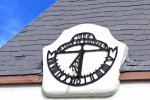 |
Solvang |
California |
USA |
Vertical Dial |
Dial 750 |
| A cast or wrought iron vertical dial about 3 foot square painted black, prominently mounted at the roof line of the Royal Copenhagen Inn. The dial face has hour lines, half-hour marks and Roman hour numerals. The dial in not quite gnomonically correct as the building declines a few degrees west of south and the gnomon appears to be at 45? rather than 34.5?. The dial is visible from Mission Road.
An interesting wind vane is seen on the roof peak above the dial. |
| |
| |
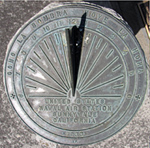 |
Sunnyvale |
California |
USA |
Horizontal Dial |
Dial 1081 |
| Farenholt sundial for U.S. Naval Air Station Sunnyvale CA. This cast bronze dial was designed and commissioned by RADM Farenholt for U.S. Naval Hospitals at bases where he was commanding officer, visited, or had special meaning to him. The dial is 18 inches (46cm) in diameter. The outer chapter ring has the motto, followed by a chapter ring with Arabic hours 6am to 6pm, raised hour lines that radiate from near the foot of the gnomon and short half-hour lines. The gnomon has graceful curves and a star cut-out in the center. Below the gnomon is the naval command name, followed by the commissioning date in the southern portion of the hours chapter ring. |
| |
| |
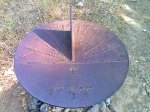 |
Ukiah |
California |
USA |
Horizontal Dial |
Dial 624 |
| A horizontal dial of welded steel plate using weld bead for hour lines and numerals. Marked for PST. |
| |
| |
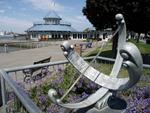 |
Vallejo |
California |
USA |
Equatorial Dial |
Dial 235 |
| A 5-foot equatorial sundial with elegant time and meridian supporting arcs. The gnomon A 5 ft. aluminum polar dial. The gnomon has the profile of the Golden Gate Bridge. Time is marked in both standard and daylight saving time with Roman numerals. The dial was a gift from Vallejo's Sister city, Akashi, Japan. |
| |
| |
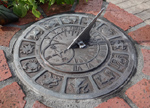 |
Ventura |
California |
USA |
Horizontal Dial |
Dial 1007 |
| The central part of the bronze sundial, approximately 12 inches in diameter, has the traditional hour marks and divisions into 15 minute intervals and surrounded by Roman numerals from 5am to 7pm. South of the gnomon is a simple compass rose with four cardinal points. With the dial at ground level the gnomon has led a hard life and is now held to the dial plate with improvised brackets. Surrounding the dial, doubling the size to 24 inches in diameter is an elegantly engraved ring of the twelve figures of the zodiac, each named on the outer ring with the corresponding month on the inner ring. |
| |
| |
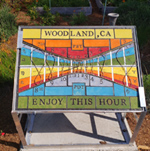 |
Woodland |
California |
USA |
Polar Dial |
Dial 1095 |
| It is a polar dial using a rod gnomon. Using a template from Shadows software, the dial is made of handmade ceramic tiles mounted on an aluminum bar frame anchored to a concrete base. Brass borders define winter and summer solstice declination lines, and an aluminum bar defines the E-W equinox declination. Copper analemmas define the sun’s annual path at 7:30/8:30 PST/PDT and hourly until 5/6PM. Metal balls along the analemmas are placed the 1st of each month. Black declination lines mark the ancient Babylonian Zodiacal signs, designated by different colors. Hours are numbered for PST and PDT. Standard time on the hour, accurate to 1 minute, is read on the tile surface when the gnomon shadow is just under the analemma for that hour. The 1st of each month is marked on tiles in early AM and late PM hours, guiding which side of the analemma is used. |
| |
| |
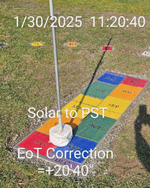 |
Woodland |
California |
USA |
Analemmatic Dial |
Dial 950 |
| This colorful analemmatic dial is an opening of the garden path made of decomposed granite. The sundial is 18 feet wide in the E-W direction and just a bit more than 9 feet in the N-S direction. Tile hour marks go from 6am to 7pm, with an additional tile above the 12-noon saying "PST" (Pacific Standard Time). Since there is no longitude correction, the sundial actually shows local solar time. But a nearby plaque with the Equation of Time allows the user to determine true civil time. Bailey Points for showing the direction of sunrise and sunset are planned The central walkway is made of colorful tiles, with each tile representing one month that is clearly labeled. |
| |
| |
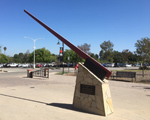 |
Woodland Hills |
California |
USA |
Horizontal Dial |
Dial 1062 |
| This is a simple, but elegant horizontal dial. A large gnomon pointer sits on a trapezoidal pedestal, creating a large horizontal dial. Surrounding it on a concrete plaza are circular hour marks with standard and daylight saving time. |
| |
| |
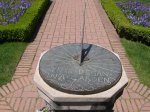 |
Woodside |
California |
USA |
Horizontal Dial |
Dial 558 |
| A 15 inch diameter well-patinaed horizontal bronze dial on a stone pillar. This dial was designed for a different location. The hour lines are cut for 50? N; the gnomon angle is 46.5? and is miss-located on the dial face. |
| |
| |
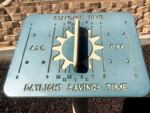 |
Yucaipa |
California |
USA |
Polar Dial |
Dial 1056 |
| This polar dial on a plate 24 inches wide by 14.5 inches tall (61 x 37 cm) and is on a stand about 50 inches (127cm) high. Shows both Pacific Standard (7AM - 5PM) and Daylight Saving Time with hour marks only. Sun motif in the center below a long gnomon. |
| |